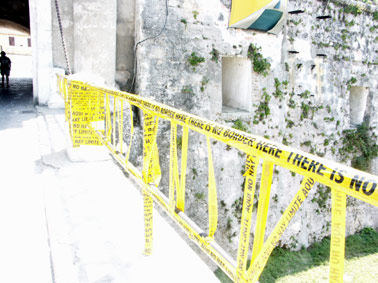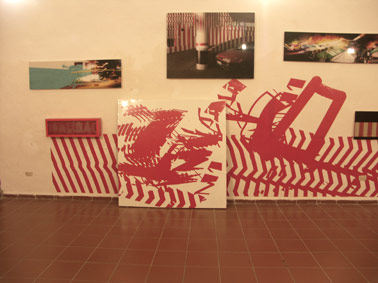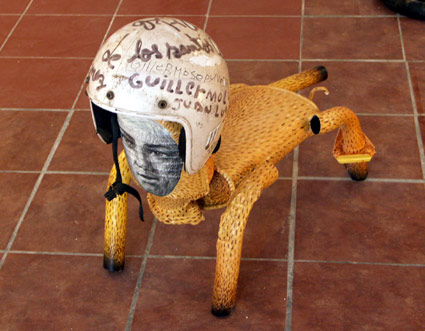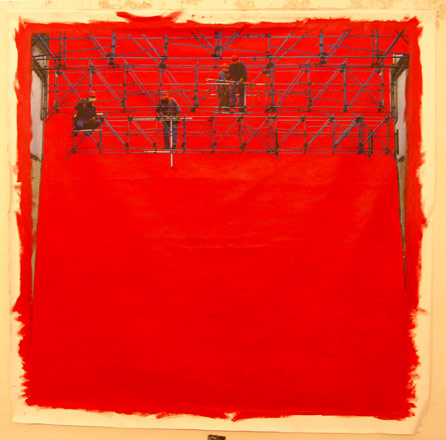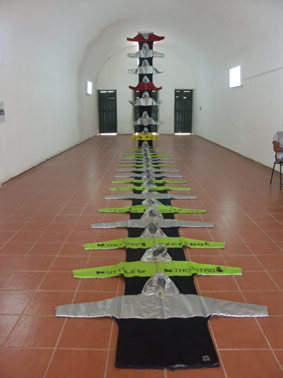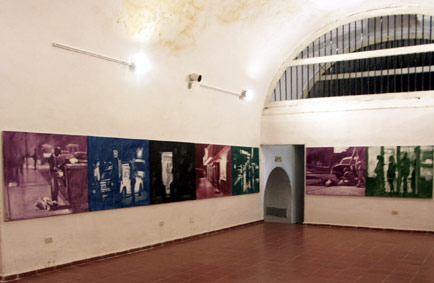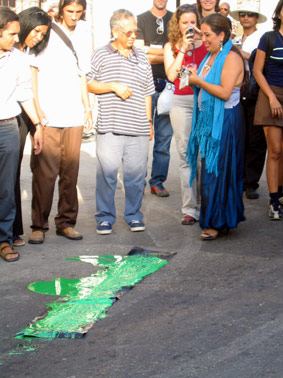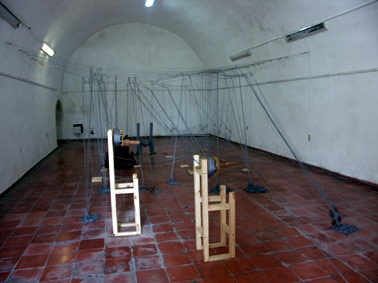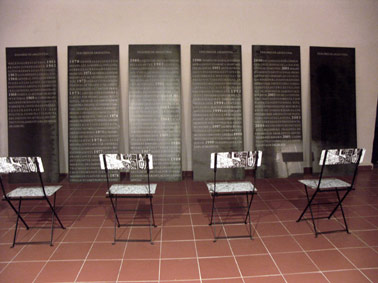Something
similar happens to cities as to identities: for a long time they were
considered structures with closed orders, with stable and unchangeable
physiognomies. Only modernity in architecture attempted to transform
the spaces of the cities through “more or less Utopian innovations”.
However, the post-modern impact on structures inherited from that modernity,
the displacement towards the orbs of increasingly large in numbers and
diverse populations, the acceleration of the pace of life, the hegemony
of publicity and the overwhelming density of traffic, transformed them
into complex cartographies, not only topographical but also social,
administrative, habitational and cultural.
More
and more people leave the rural areas and decide to face the adventure
of settling down in the cities. Such a demographic overflow generates
an intense and irreversible cycle of urbanization. In a process whose
scale and vertiginous pace no one has ever dared to imagine before.
Some statistics illustrate that growth. Recent facts published in connection
with the World Environment Day (2005) estimates that, about half of
the population of the planet lives in urban areas today, but by 2030
the number will increase to 60 per cent. At such a pace there will be
23 megalopolis by 2015, with more than ten millions inhabi-tants each,
and 19 of them will belong to the developing world, with little chance
to successfully face the serious problems posed by such a growth.
At
this moment, 75 % of the populations of the developed countries live
in urban areas. In them, urbanization has to a high extent coincided
with the growth of wealth and the economy. But the situation is quite
another and much more disturbing for the countries of the South, considering
that more than half of the euphemistically called “developing”
nations will live in cities by 2020. Today, about a billion people,
especially in Asia, Afri-ca and Latin America live in shantytowns or
illegal settlements.
Considerations
of this nature locate the subject of the city and the urban culture
in the epicenter of contemporary studies. Lately the city, and everything
taking place in it, is in the focus of attention of social sciences
and also an element not to be misestimated by the Arts, being the subject
of innumerable actions and curatorial practices. It suffices to remember
for example, InSITE 97, at the US-Mexican border (in the cities of Tijuana
and San Diego); Iconografías Metropolitanas at the 25th Biennial
of Sao Paulo, 2002; Todo Incluído. Imágenes Urbanas de
Centroamérica, Madrid, 2004; P.R. 00 and P.R. 02, in San Juan,
Puerto Rico; Ciudad múltiple, Panama City, 2003, and La ciudad
Ideal, Biennial of Valencia, 2003, among others.
One
could state that the structural and social agony of the cities is not
new. Since the decade of the 80’s in the last century, the globalizing
policies and the de-territorialization of the economic, financial, and
market structures rooted in neoliberalism accentuated the differences
and inequalities between the different geopolitical areas of the planet.
Such disproportions favored the sudden flight of large human masses
towards the most well-off settlements of the industrialized north or
towards the best qualified ones in the Third World – human displacements
that were fed by the multiplication of poverty, the resurgence of the
international or regional conflicts, ethnic-religious disagreements,
or environmental problems and the changes in the climatic behavior at
the global level.
The
Caribbean is a good example of such large displacements. Five years
ago, the Venezuelan artist Ricardo Benaím emerged in Havana with
the emission of a Caribbean currency functioning as monetary unit for
all the region and having financial equivalences with the exchange tokens
of the world’s strongest and most widely used currencies.1
Presented like a street performance, he installed a small stage scene
in the guise of a portable exchange office whose appropriation of the
banking procedure of exchange of bank notes was a meddlesome gesture
from the Arts in the international mechanisms of economic and financial
power. That act connoted the preca-riousness of the tourism industry
dependent, or resource scarce Caribbean economies forced to devise common
subsistence strategies in front of an adverse panorama governed by mechanisms
of pla-netary articulation, by the conformation of competitive interregional
geopolitical and economic blocks, willing to face the new rules of the
game of globalization. Such disadvantages upon which Benaím reflected
condition the migratory exodus of the populations of the area.
So,
the “mirage of the progress”, the idea of the big city portrayed
as an earthly paradise, with better job sources, services, housing facilities,
and quality of life, contributes to the overwhelming physical and social
impact of the invasion of insufficient spaces by huge human conglomerates,
who bring along an exaggerated deterioration of the main urban centers
by an uncontrollable population overflow. The definition of the problem
formerly known as the phenomenon of “capitalness”, circumscribed
to internal movements towards the capitals, no longer describes the
syndrome of the cities objectively.
The unfinished modernizing efforts enhanced the hypertrophy of the urban
constructs. Years back, Néstor García Canclini summarized
some of the consequences of that modernizing effort for Latin America,
pointing that “without houses, neither sanitary services, nor
sufficient schools, nor works, and above all, without regulating plans
nor adequate investments, the disordered growth of the peripheries and
the degradation of the downtown areas of the large cities engendered
huge metropolis (...) and average cities in rampant overgrowth, whose
predominant traits are the opposite of the modern project: instead of
a rationalization of public life, the chaos produced by the privatization
of the urban space made by millions of cars and tens of thousands of
traveling salesmen; the industrial development, the formal and informal
commerce were aggravating year after year, the contamination of the
soil, water and air”2, something that reminds
us of the almost subliminal background of Ridley Scott’s dark
city in the film Blade Runner.
Translating
all these arguments, one could speak of those problems in relation to
the evident, ultramo-dern, organized great cities of the industrialized
world, but it would be very different to identify them in the South
of the world, and it would be actually naive to compare, in spite of
the formal analogies, Chirs Burden’s “futuristic metropolis”
with the “architectonic simulations” of Bodys Isek Kinguelez
(Congo), critically loaded by the colonial history of Africa and their
fiduciary role in the economic prosperity of the West.
The
nations of Latin America, Asia or Africa mark the antipodal of the wealth;
among their extensive realms of exclusion the marginalization of the
habitat prevails. The ample belts of poverty surrounding the capitals,
be those favelas of Brazil, the hills of Caracas or the new towns of
Lima, defined dark zones full of social conflicts, segregation and insecurity
conveniently hidden from indiscreet glances behind advertising campaigns
and governmental policies, so that they never dim the seductive pages
of tourism brochures. A good illustration in this case could be the
Central American isthmus. Sold like a paradise of ecology and bio-diversity,
the history though is very different ; one of many metropolitan enclaves,
true paradigms of chaos and absence of planning.3 The
prevailing insecurity in them forces their inhabitants to live “behind
a fence”, or to contract the services of protection agencies.
Years ago, the Costa Rican artist Federico Herrero made, perhaps tangentially,
refe-rence to the subject in a series of interventions in monitoring
booths in San Jose, whose functionality he modified by turning them
into “public toilets”, etc. His project documented the proliferation
of this new architectonic typology that already is a distinctive trait
of some Latin American cities.
The
agony of the concepts relative to the modern city imposes a challenge
to the normative will of the states, tearing to pieces the Utopian conceptions
about the social organization of life and expectations and making the
capacity of architects and city planners unusable to design spaces and
territories appropriate to its various functions, among which excels
the fragmentation of its structure and functions. Perhaps, the last
totalizing project upon this space was the one designed by the architectonic
rationalism in the Chart of Athens, with an attempt to separate the
four basic functions, and whose failure is well-known to all.
Several
derivations exemplify the morphologic complexities present in the landscape
of the urban. One of them is the alienation of the postmodern building,
described by Fredric Jameson when he pointed out that the traditional
or mo-dern city is replaced by the postmodern variant of self-contained,
isolated minuteness. Jameson mentions examples such as Beaubourg, in
Paris and the hotel Westin Bonaventura, of Los Angeles, prototypes of
a hyperspace that aspires to be a substitute or an equivalent for the
city itself, without pretending that these affect the transformation
of the surroundings or articulate with them.4
Another
set of problems point at the blur of the borders between centrality
and periphery, the assimilation of the old margins and other nearby
communities that turns cities into over-populated metropolises. Some
authors (among them, Robert Segre and García Canclini) have drawn
the attention to how in this process it is very common to observe that
a given habitual matrix takes over surrounding spaces in such a way
that the spaces end up juxtaposing the architectonic and urban inconsistencies
of various different enclaves.5 The mega-city, or the
most complex version of the present large city: megalopolis (a term
coined by the city planner Jean Gortmann), defines the totally new operation
of “co urbanization”, the latter understood as the fusion
of great co-adjacent habitational nuclei that dilute their edges indefinitely,
articulated around the main graticule of the city, something that can
be seen in the groupings of big cities of the West and Atlantic coasts
of the United States – something to that will happen in other
latitudes, such as in calm regions of the Central American isthmus,
like Heredia, San José and Alajuela, in Costa Rica.
Without
pretending to exhaust such a complex subject, other questions present
an alternative like the Generic City, an Asian postmodern correspondence
to the rationalist Brasilia – a consequence of the devastating
power of universalizing formulas6, or the new prolongations
of the “plaisir” city, modeled after Las Vegas or Disneyland,
in the present versions of the thematic parks and the new structures
of leisure.
The
urban territory becomes spongy, of a never before imagined porosity.
The contemporary discourses on the nomadic and the displacements give
a turn to this subject that goes beyond its dramatic human or affective
effects, as was the focus back in the 80’s and the 90’s.
Seen from this perspective mobility acts like a destabilizing wedge
in the good sense, because it generates changes within the established
sociocultural strata. The artistic readings on trans-territoriality
can show very diverse nuances. The “ubiquity” of the “global
actors” lie at the base of the ambiguity of meaning strategically
projected in some of the experiences, for example, of Gabriel Orozco7,
one of the paradigms of the “de-localized artist”. The systematic
use of nomadic codes also influenced deliberately in the Ciudad Transportable
de los Carpinteros (Cuba) displayed during the Seventh Biennial of Havana
in 2000. That installation created with tents reproducing some of the
architectonic symbols with which diffe-rent manifestations of power
in the island were represented, from the politician to the monk, insisted
on that provisional state of the contemporary experience, at the same
time that it connoted the instrumental or idiosyncratic symbolic value
what is dragged along with each travel.
The
collapse as a socially homogeneous or foreseeable space, subordinated
to the introduction of new individuals and social groups, to the inter-crossing
of the lives, memories and histories of men, affects the new human and
social relations, and the construction of new identities. 8
Their consequences are observed in the contemporary “Babels”:
London, Berlin, New York or Los Angeles, but they are also acting in
an incisive way in other, less cosmopolitan contexts, such as Lima in
Peru, whose identity structure continues to thrive at the intersection
of inha-bitants from the coast, the mountain range and the forest. This
implies also the disappearance of the centered subject defended by canons
of modernity. This modification of the individual dramaturgy depends
on the characteristics and conditions of each particular experience,
and interprets the instability of a subject devoided of its sense of
location in space, who cannot identify its own position in the new urban
totality and must redraw its orienting coordinates according to new
practices of insertion in the collective corpus and the urban mesh.
This cognitive and cartographic incapacity is subordinated to the difficulty
- pointed by Jean Baudrillard - of safeguarding the self-identity at
a time in which the old aspiration “of looking like the others
and to losing oneself into the multitude” has been replaced by
the obsession “of just looking like oneself”.9
Such disorientation leads Fernando Castro to metaphorize the public
context with an abyss by which we ramble. Perhaps because of this, the
situationists went to the opposite end of what was understood by the
architectonic modernism, enunciating the drif-ting away in terms of
mobility and interrelation, or a reading of a space subordinated to
the fragmented landscapes that the human being configures along his
usual journeys10, an undoubtedly influential perspective
in some contemporary artistic practices, of performative character,
interested in exploring art like an everyday process or experience,
in the style of the urban journeys of Francis Alÿs (Belgium-Mexico).
The
temporality generated in the culture is one of the most attractive consequences
of this situation. When having access to cities and the creation of
new communities, the new social subjects upset the composition, the
character and the diversity of the urban surroundings. It could be said,
in addition, that this is one of the scenes where the straining contaminations
between the global and the local are prolonged. These new subjects carry
with themselves their customs and their habits; they are carriers of
the new cultural sensitivities and traits, and they penetrate the crevices
of the context that assimilates them, orchestrating enriching intercultural
experiences. I do not refer to the worn out multi-cultural axiom, justly
defined by Gerald Mosquera as a “prison without walls”,
but to another type of “transaction”.
In
the cities, many realities coexist simultaneously. The visual culture
channels in some ways the ecstasy and the fascination for the objects;
it responds to a promiscuous coexistence of images of various origins,
fundamentally ordered by means of hegemonic and homogenizing strategies
of mass-culture and the transnational companies. The photographer Walker
Evans can be a forerunner in the early recording of that crowded universe
of signboards, advertisements and comic books with essays like Habana,
1933, where the voracity of images was already perceived as ac-ting
upon the individual. But it would be the New Dada and the Pop who legitimized
the popular ima-ge, the serial products and the trivial object obsessively
stereotyped in the urban life. The difference between their transcriptions
and the present time lies in the hallucinating level of global circulation
reached today by products like Coca-Cola or McDonald’s, at the
level of communicative effectiveness of posters, the huge advertising
fences, the neon ads, the giant TV-screens, the TV-commercials or the
soap operas, that saturate all the corners of the planet and stimulate
operations of simulation among a population historically familiarized
with the means of the cultural industry. This reproduces the dualities
between the lived reality, full of unsatisfied shortcomings, and its
mediatically consumed transcription - a virtual replacement for the
existential emptiness of necessity created and imposed by advertising
means, and by a more and more ephemeral cultural system of values.11
The hegemony of the high-tech sign has drawn the longest straw, and
it substantially modifies the ways of life, the social behavior, the
customs, the beliefs, being of interests even to the religious practices
of the common human being.
At
the same time, one of the resulting products of that mechanism is the
two-way cultural interchange. Although the apparent universalization
of the experience of consumption in non-developed contexts gives new
leases to collective projection, which solves these dichotomies by means
of cultural assemblies and hybrid products 12, the
accumulation of images and sounds stemming from the popular imaginary,
propelled by the spontaneous initiative of people, it structures a new
meaning for that visual culture facing the passer-by. Also, they actively
influence the new identity- or cultural expressions being basically
constructed in urban scenes, whose referents stem from an iconography
already present in public transportation, in the advertisements of the
small and medium companies, in the crowded stands of the street markets
and other scenes of the informal economy, and in the traits of the ethnic
minorities or gay communities.
Other
manifestations exist not to misestimate in that symbolic polyphony,
such as the street speech, the background noise, the performance dimension
of human activity, the everyday gestures or bodylanguage of the people,
or the sonorities of popular musical expressions like hip hop, reggaeton
or the Andean techno-cumbia. All those being very complex phenomena
appealing to the youngest sector of the population.
On
the other hand, while the guidelines of a postmodern conception draw
a map of new, randomly scattered hierarchies, the most novel typologies
supplant functions once entrusted to traditional spaces of the public
and domestic life. A new order of symbolic indications, territorial
po-wers and mutations replaces, and in fact makes the traditional notions
of centers, of parks and squares, on which most of the articulation
of the public space and social communication rested useless.13
What Jacques le Goff defined as “places of memory”, that
is, the historical or religious archetypes, have been forced to coexist
with the glamour of the mall, with the big boulevards, the omnipre-sent
visibility of companies and trade marks, all those short hands for the
“society of the spectacle”. Their old seat of honor is occupied
by the fenced residential areas, the condos, the transnational emblems
of urban progress, banks, corporations, the towers of steel and glass,
satellite dishes or the great shopping malls, declaring dysfunctional
churches and cathedrals (their domes and bell towers), monuments and
the pillars of government power, referents that until then acted as
significant landmarks in the urban landscape.
Logically,
all of them affect the redesign of the landscape concept nowadays, oxygenating
the contemporary practices of the genre. In the middle of the 90’s
the artistic scene largely moved towards the recovery of the files of
the personal or collective memory, locked up in the impasse of the document
or of the so-called “archive disease”, this domination is
now replaced by the re-formulations of the landscape, their recent re-orientations
- where the archaeologically grounded ideas and the psycho-social constructions
or photographic records stand out -, largely articulated around the
changing potentialities of the urban text, that is, the radical transformations
of the image of the city, their new cartographies, the chaos, the fragmentation
and their inherent disorder, the tensions between tradition and unfinished
modernity, the contradictions between the rural and the urban, as well
as the new media mar-kers spread around its vast territory.
Finally,
it is necessary to consider the emphasis in the productions destined
to the urban space, known indifferently as public art, urban art or
other denominations. According to García Canclini, the art for
that context is no longer conceived from the simplistic or romantic
formula of moving the works out of the museums with the purpose of “qualifying”
the realm of the urban neither is it achieved through the commemorative
transcendentalism that filled our cities of statues, obelisks and monuments.
The
increasing interests in expanding the frontiers of art beyond the sacrosanct
inner enclosures of the museum or the gallery moves along another path,
in connection to the peculiarities of the surroundings, their meaning
and their history, with the inhabited communities crossing it or daily
modifying it. The production of meanings in this case revalues the “appropriation
and the use” of that public space by anonymous beings, and directly
affects the image of the city; its actions have a very volatile, process-orien-ted,
social, cultural and political reason to exist that is reshaped in everyday
life.
Many
are the artists whose proposals have the open spaces and the architecture
as a fundamental scene, where they create experiences of identity-oriented,
cultural, or social repercussions, establish links between the existential
and the urban and social structure. They explore often hidden or completely
anonymous communicative mechanisms, they articulate their actions or
interventions camouflaged with the passer-by and they are more interested
in “living” the experience of art than in documenting it
or turning art into life experience. They accept the codes imposed by
the city to deconstruct the daily rituals, to place objects in it, to
generate mechanisms of social insertion or to scatter imperceptible
or disturbing performative quotations within the landscape, always returning
to the fractures between the artist and the public, the inside and the
outside, the public and the private.
Among
the practices designed for those spaces, there are experiences of de-institutionalization
aiming at giving back the voice to the inhabitants of the urban communities,
to open alternative radial, journalistic or medial interstices, in function
of broadcasting their lives, their histories and their memories. The
space of the museum or the gallery can also be submitted to an operational
de-construction through ambulant museums or fictitious vernissages conceived
to interact outside those enclosures, on the sidewalk or the street.
Also,
the quotations of the informal variants of the market place acquire
the form of kiosks or ambulant simulations of vendor stands, in these
cultural cases. One of them, the Colectivo Cambalache (Carolina Caicedo)
makes a parody with its name as a kind of ancestral, fetishist barter
in order to displace it towards the realm of the artistic.
These
and other reasons make us look towards the conflictual character implicit
in the city, towards the impact of today’s urban cultures, from
an open, plural position that takes the benefits inherent to the city
as well as the various unsolved contradictions inside it as much into
account. It equally explains the primacy that this space acquires within
the contemporary artistic or curatorial practices. The city is presently
a compulsory point of reference; it has become a territory to explore
new visual potentialities, to find other possible ways to expand the
reach of art beyond the walled enclosure of the gallery or the museum,
of the wicked space of the commercial, to disassemble its restrictive
alibis. It is very probable that the museum, the gallery or the market
will never die, neither paintings nor history, but the city and the
public space are without a doubt a new alternative and their greatest
competitor is the place in which, as Harald Szeemann predicted, the
unforeseeable art of the future will occur.


